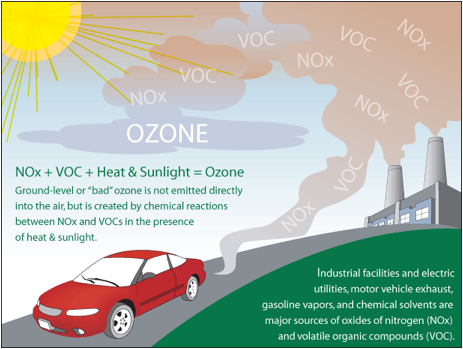Ozone is a highly reactive, colorless gas pollutant that is not typically emitted directly into the air by any one source. Instead, ozone is considered a secondary pollutant, which means that it is formed through complex chemical reactions of molecules in the air. Specifically, ground-level ozone is formed when nitrogen oxides (NOx) and volatile organic compounds (VOCs) chemically react in the presence of sunlight. While ozone high up in the atmosphere protects us from harmful ultraviolet rays, exposure to high concentrations of ground-level ozone can be quite harmful to our health and environment. That is why we say ozone is “good up high, but bad nearby”.
High concentrations of ground-level ozone can create breathing problems, especially for children, people with asthma or other respiratory problems, and adults who work or exercise outdoors. According to the U.S. Environmental Protection Agency, ozone can also cause tree and crop damage. Mobile sources of air pollution such as cars, trucks, and lawn equipment, contribute to nearly half of the ozone formed in South Carolina.
High ozone concentrations generally occur on hot, sunny days in the spring and summer when the air is stagnant, and the sun’s rays shine more directly on the earth’s surface. Like the weather, ozone and its precursor pollutants can be transported from place to place by wind, resulting in significant changes in ozone concentrations from day to day and even hour to hour.
Contact: Greg Quina at Gregory.Quina@des.sc.gov or call (803) 898-4074.



